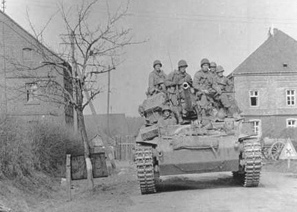After the Allied crossing of the Rhine, on 23 and 24 March 1945, British and Canadian troops advanced north of the Ruhr area into the German hinterland. On April 1, they met with the U.S. troops operating south of the bridgehead of Remagen near Lippstadt. This meant that more than 300,000 German soldiers of Army Group B, remnants of some 21 divisions and millions of civilians were trapped in an area completely destroyed by previous bombing raids.
The way towards the heart of Germany lay free.
After Thuringia had been relatively spared in Europe since the beginning of the war, the last weeks of the war also claimed numerous victims and great destruction.
The liberation of Thuringia lasted almost two weeks. It began early morning of April 1, 1945, American troops advanced von Hersfeld towards Werra. They were already in Altenburg on April 16. Despite the rapid advance and military superiority, regional Nazi officials continued to call for resistance. With the liberation of Ohrdruf and Buchenwald, the US soldiers were also confronted for the first time with the human suffering in the concentration camps. The 16 days in April 1945 marked the end of the Nazi “Mustergau” of Thuringia and sealed the looming end of the Third Reich, despite the Nazi slogans.
On April 4 and 5, the soldiers of the Counter Intelligence Corps, affiliated with the 90th Infantry Division, received the information that the gold of the Deutsche Reichsbank was in the Merkers salt mine.
The surrender of Eisenach to the American troops took place on April 6, after heavy artillery fire.
On 7, 8 and 9 April, 7 people were killed in airstrikes on Kahla.
The forced laborers of the “REIMAHG”, who were still able to walk, were driven to a march towards Bavaria, in which many died. Sick and weak forced laborers were left behind in the Leubengrund Valley, in Lager 7.
On April 11, units of the 4th and 6th Armored Division of the 3rd U.S. Army continued their advance from Gotha via Erfurt to the East. In the late afternoon, a reconnaissance force of the 6th Armored Division reached the Buchenwald concentration camp. The Saale Bridge near Jena was blown up by the Wehrmacht. The Kahlaer Volkssturm took position on the eastern bank of the Saale.
The battlegroup Taskforce Crater organized in Riechheim, Hohenfeld, was a part of the 89th Infantry Division, attacked Blankenhain in the morning of April 12 and Erfurt was occupied by the 3rd US Army.
The Saale bridges between Rothenstein and Zeutsch were blown up by the Wehrmacht and caused considerable damage to the buildings.
On the same day, in the afternoon, U.S. President Roosevelt dies at the age of 63. U.S. Generals Eisenhower, Bradley and Patton visit the liberated Ohrdruf concentration camp.
Jena is handed over to the 80th Infantry Division the next day without a fight.
Taskforce Crater is divided into three other battle groups, two of which advance via Bad Berka towards the Saale. The third group remained as a reserve. Kesslar and Blankenhain intense fighting takes place. The aim of the advance is to secure the bridges over the Saale near Rothenstein, Grosspürschütz, Kahla, Freienorla and Zeutsch.
On April 13, in the late afternoon, a German tank of the 11th Panzer Division will be taken out by the advancing US units in Kahla. The German crew manages to escape and hide.
From the East side of the Saale, coming from Hummelshain, heavy artillery fire is fired at the Americans. Four soldiers of the U.S. combat group drowned while crossing the Saale near Rothenstein.
The NS aircraft factory “REIMAHG”, located between Kahla and Großeutersdorf, is occupied. A few days before, “enemy alarm” was already given here and all the files went to the Kahla porcelain factory to be destroyed, the forced laborers who were still able to walk marched towards the southeast.
At the end of the day, U.S. units crossed the Saale in a broad front, despite the bridges being blown. They used storm boats and ferries and used a repaired pedestrian bridge in Rothenstein. Arriving on the east bank, they discover on their advance in the Leubengrund Valley Lager 7 of the “REIMAHG”, in which the sick and dying forced laborers were left behind. The “REIMAHG” hospital in Hummelshain is also being taken and will continue to be used as a hospital.


On this 13th of April, the Second World War was finally over in Kahla. The Kahla citizen Carl Budina is appointed acting mayor by the Americans.